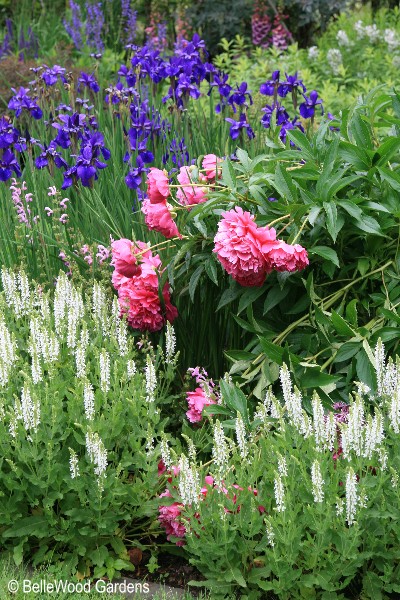
Wednesday, 27 May 2009
A Visit to the Arboretum at Temple University Ambler
An overcast morning and spattering of rain was hardly sufficient to deter some enthusiastic Tohickon Garden Club members. Carpooling for convenience, company (and besides, it saves on gas.) So off we went, to visit the gardens at the landscape arboretum of Temple University Ambler . Officially designated an arboretum in March 2000, the campus has a long history with a rich tradition of horticulture and landscape design. Established as the Pennsylvania School of Horticulture for Women in 1910, the 187-acre campus represents a unique mix of natural and designed landscapes.

I was fascinated with the cold frames. Sturdy and well built,
they are clearly put to regular use for plant propagation.

An arbor supports our native American wisteria, Wisteria frutescens.
While the racemes of flowers are more compact than the Asian species,
flowering time may be, to some extent, controlled by time of pruning.
Carpenter bees were also making use of the arbor, boring holes for
their egg-laying, grub-rearing, reproductive cycle. Sawdust, anyone?

Today the Ambler campus is home to Temple University's Department of Landscape Architecture and Horticulture. The gardens and campus serve as excellent outdoor teaching laboratories for numerous classes. There are several gardens intensively used as outdoor living laboratories and teaching aids, including an herb garden, ground cover garden, native plant garden, formal gardens, rock wall, woodland garden, wetland garden, trial garden, and large perennial borders.

The perennial borders are the premier historic horticulture feature of the campus. Designed by James Bush-Brown and Beatrix Farrand, the long formal garden space is enclosed by an arborvitae hedge which serves as a backdrop to English-style perennial borders. The perennials and shrubs filling the borders today reflect a more modern plant palette. Stephanie Cohen and Rudolph Keller led the garden's most recent restoration in 1998. Notice the patriotic trio of flowers in bloom.

Well, close to patriotic red, white, and blue. Very double pink peonies
nodding over, having soaked up rain water like so much blotting paper,
dark blue-violet Siberian iris, (probably the cultivar 'Caesar's Brother')
and upright white spikes of Veronica spicata 'Icicle'.

A closer look at the pairing, and closer yet at the iris
to see rain drops clinging to the petals. Siberian iris
are an excellent choice for the garden, easy to grow
and attractive sword-like foliage for later interest.

We were all attracted to another, yellow and butterscotch iris.
It is, I think a cultivar of Dutch iris, whose corms were planted
last fall. Interesting, and unusual, striking color.

.

No wonder we're admiring the flowers. There's so much to see.

Such as this clever pairing of Allium christophii with
purple-flushed leaves of Eupatorium rugosum 'Chocolate'.
Handsome purple-flushed leaves disguises the ornamental onions
vanishing foliage and will also add a second season of interest
when the snakeroot flowers in late summer.

Geometric little 6-pointed stars form a constellation of flowers.
Allium christophii looks terrific in bloom, equally attractive in seed.

Foliage has much to recommend it too. Just look at the frosted underside
of this Silphium. Prairie dock grows big, so give the stately plant
room to spread. And unless you deadhead away the aging yellow flowers
it will happily volunteer hither, thither, and yon around your garden . . . .

Here's Jenny Rose Carey in her wellies and raincoat.
Director of the landscape arboretum, she's leading us
into the labyrinth. An excellent tour guide, she gave us
chapter & verse, historical facts & plans for the future.
A pleasant outing in the company of friends, nothing better.
